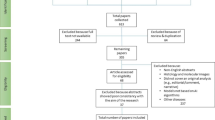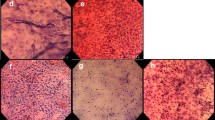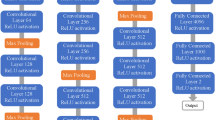Abstract
Esophageal cancer is the eighth most common cancer in the world. Currently, the incidence of esophageal cancer is increasing annually. Early detection of esophageal cancer can significantly improve the prognosis and quality of life of patients. However, detection of esophageal tumors remains a challenge because it depends on the experience, expertise and skills of the endoscopy physician. Early esophageal cancer can be easily misdiagnosed because the lesions are not obvious. Therefore, we propose a deep learning method based on a convolutional neural network (CNN) model for automatically classifying early esophageal cancer. We first process the color esophageal images by using grayscale processing, Meijering filtering and hybrid Hessian filtering before entering the network. Then, we input the processed images into the corresponding streams for feature extraction and conduct feature fusion through the add layer. Finally, the fusion features are classified and detected. We train and test the three-stream–esophageal cancer classification network (TS-ECCN) using 635 images. Macroaveraging and microaveraging, which are more suitable for measuring multiple classification problems, are used as statistical indicators to evaluate the accuracy of the model diagnosis. The areas under the receiver operating characteristic (ROC) curves (AUCs) were 0.97, 0.99 and 0.98 for classifying early cancer, cancer and normal tissue, respectively. The macroprecision, macrorecall and macro-F score of the TS-ECCN were 88.7%, 86% and 87.1%, respectively. The microprecision, microrecall and micro-F score were 89.4%. We validated the ability of a CNN-based algorithm to automatically classify early esophageal cancer from endoscopic images. This algorithm will greatly reduce the workload of endoscopists, improve the efficiency and accuracy of examinations, and become an effective means of clinical auxiliary diagnosis.







Similar content being viewed by others
References
Alagappan M, Brown JRG, Mori Y, Berzin TM (2018) Artificial intelligence in gastrointestinal endoscopy : the future is almost here. World J Gastrointestinal Endoscopy 10(10):239–249
Balasubramanian M (2002) The isomap algorithm and topological stability. Science 295(5552):7a–77a
Bang C, Cho B, Baik G (2020) Automated classification of gastric neoplasms in endoscopic images using a convolutional neural network. c Georg Thieme Verlag KG 52:eP295 1
Bo L, Ren X, Fox D (2010) Kernel descriptors for visual recognition[C]//Adv Neural Inf Process Systems. 244–252
Bochkovskiy A, Wang CY, Liao HYM (2020) Yolov4: Optimal speed and accuracy of object detection. [J]. arXiv preprint arXiv:2004.10934
Boeriu A (2015) Narrow-band imaging with magnifying endoscopy for the evaluation of gastrointestinal lesions. World J Gastrointestinal Endoscopy 7(2):110
Borgli H, Thambawita V, Smedsrud PH, Hicks SA, Lange TD Hyperkvasir, a comprehensive multi-class image and video dataset for gastrointestinal endoscopy. Sci Data 7(1):1–14
Chen Y, Xie X, Zhang T, Bai J, Hou M (2020) A deep residual compensation extreme learning machine and applications. J Forecast 39(6):986–999
CMPS P, DTHD M, RBP A, Guedes HG, Kumbhari V, EGHd M (2017) Lugol’s iodine chromoendoscopy versus narrow band image enhanced endoscopy for the detection of esophageal cancer in patients with stenosis secondary to caustic/corrosive agent ingestion. Arquivos de gastroenterologia 54(3):250–254
Dayan P, Abbott L (2001) Theoretical neuroscience: computational and mathematical modeling of neural systems. Philos Psychol 15(1):154–155
Ding Z, Shi H, Zhang H, Meng L, Hou X (2019) Gastroenterologist-level identifcation of small-bowel diseases and normal variants by capsule endoscopy using a deep-learning model. Gastroenterology 157(4)
Du X, Li Y, Yao J, Chen B, Yang X (2018) Loid-eec: Localizing and identifying early esophageal cancer based on deep learning in screening chromoendoscopy. in: the 2018 the 2nd International Conference, pp.17–22
Duchi J, Hazan E, Singer Y (n.d.) Adaptive subgradient methods for online learning and stochastic optimization. Vol. 12
Frangi RF, Niessen WJ, Vincken KL, Viergever MA (1998) Multiscale vessel enhancement filtering. Lect Notes Comput Sci 1496:130–137
Godbole S, Sarawagi S (2004) Discriminative methods for multi-labeled classification :22–30
Guo LJ, Xiao X, Wu CC, Zeng X, Zhang Y, Du NPJ, Shuai Bai NP, Jia Xie NP, Zhiwei Zhang MS, Li BS a Y (2020) Real- time automated diagnosis of precancerous lesions and early esophageal squamous cell carcinoma using a deep learning model (with videos). Gastrointest Endosc 91(1):41–51
Hai X, Haijun L, Xianlu Z, Yejun H, Guozhen C, Ahmed E, Guanghui Y, Jiantao W, Guoming Z, Baiying L, Amd-gan (2020) Attention encoder and multi-branch structure based generative adversarial networks for fundus disease detection from scanning laser ophthalmoscopy images. Neural Netw 132:477–490
He K, Zhang X, Ren S, Sun J (2016) Deep residual learning for image recognition. in: IEEE Conference on Computer Vision & Pattern Recognition, pp.770–778
Hinton G, Roweis S (2003) Stochastic neighbor embedding. Adv Neural Inf Proces Syst 15(4):833–840
Hirasawa T, Aoyama K, Tanimoto T, Ishihara S, Tada T (2018) Application of artificial intelligence using a convolutional neural network for detecting gastric cancer in endoscopic images. Gastric Cancer Official J Int Gastric Cancer Assoc Japanese Gastric Cancer Assoc 87(Suppl 1):1–8
Huang G, Liu Z, Maaten LVD, Weinberger KQ (2017) Densely connected convolutional networks. in: CVPR, pp. 4700–4708
Kandiah K, Chedgy FJQ, Subramaniam S, Thayalasekaran S, Handari PB (2017) Early squamous neoplasia of the esophagus: The endoscopic approach to diagnosis and management. Saudi J Gastroenterology Official J Saudi Gastroenterology Assoc 23(2):75–81
Kazuhiro G, Takashi O, Masahiro Y, Nagaaki O, Hirohisa M (2004) Appearance of enhanced tissue features in narrow- band endoscopic imaging. J Biomed Opt 9(3):568–578
Kingma DP, Ba J (2022) Adam: A method for stochastic optimization. arXiv
Kruskal JB, Wish M, Uslaner EM (1978) Multidimensional scaling. Book on demand pod
Laurens VDM, Hinton G (2008) Visualizing data using t-sne. J Mach Learn Res 9(2605):2579–2605
Lin TY, Dollar P, Girshick R, He K, Hariharan B, Belongie S (2017) Feature pyramid networks for object detection. in: 2017 IEEE Conference on Computer Vision and Pattern Recognition (CVPR), 2017, pp.2117–2125
Liu DY, Gan T, Rao NN, Xing YW, Zheng J, Li S, Luo CS, Zhou ZJ, Wan YL (2016) Identification of lesion images from gastrointestinal endoscope based on feature extraction of combinational methods with and without learning process. Med Image Anal 32:281–294
Meijering E, Jacob M, Sarria JXCF, Steiner P, Hirling H, Unser M (2002) Design and validation of a tool for neurite tracing and analysis in fluorescence microscopy images. Cytometry Part A 58(2):167–176
Moenig S, Chevallay M, Niclauss N, Zilli T, Fang W, Bansal A, Hoeppner J (2018) Early esophageal cancer: the significance of surgery, endoscopy, and chemoradiation. Ann N Y Acad Sci 1434:115–123
Nelder JA, Mead R (1965) A simplex method for function minimization comput. Comput J, (4):4
Ng CC, Yap MH, Costen N, Li B (2014) Automatic wrinkle detection using hybrid hessian filter. in: Asian Conference on Computer Vision, pp.609–622
Njei B, Mccarty TR, Birk JW (2016) Trends in esophageal cancer survival in United States adults from 1973 to 2009: a seer database analysis. J Gastroenterol Hepatol 31(6):1141–1146
Redmon J, Farhadi A (n.d.) Yolov3: An incremental improvement,.arXiv e-prints
Sabri B, Fethi J, Mohammed EA, Quan Z (2017) Optimal classifier for imbalanced data using matthews correlation coefficient metric. PLoS One 12(6):e0177678
Saito H, Aoki T, Mmath KA, Bsc YK, Tsuboi A, Yamada A, Fujishiro M, Oka S, Ishihara S, Matsuda T a (2020) Automatic detection and classification of protruding lesions in wireless capsule endoscopy images based on a deep convolutional neural network. Gastrointest Endosc 92(1):144–151
Sebastiani F (2001) Machine learning in automated text categorization. ACM Comput Surv 34:1–47
Shanno DF (1970) Conditioning of quasi-newton methods for function minimization. Math Comput 24(111):647–656
Simonyan K, Zisserman A. (n.d.) Very deep convolutional networks for large-scale image recognition. Computer Sci
Sofka M, Stewart, Charles V (2007) Erratum to “retinal vessel centerline extraction using multiscale matched filters, confidence and edge measures”. IEEE Trans Med Imaging 26(1):133–133
Szegedy C, Vanhoucke V, Ioffe S, Shlens J, Wojna Z (2016) Rethinking the inception architecture for computer vision. in: Proceedings of the IEEE conference on computer vision and pattern recognition, pp.2818–2826
Thambawita V, Jha D, Riegler M, Halvorsen P, Hammer HL, Johansen HD, Johansen D (2018) The medico-task 2018: Disease detection in the gastrointestinal tract using global features and deep learning in: MediaEval 2018, 2018
Van Der Sommen F, Zinger S, Schoon EJ, De With P (2014) Supportive automatic annotation of early esophageal cancer using local gabor and color features. Neurocomputing 144:92–106
Van Riel S, Van Der Sommen F, Zinger S, Schoon EJ, de With PH (2018) Automatic detection of early esophageal cancer with cnns using transfer learning. in: 2018 25th IEEE International Conference on Image Processing (ICIP), IEEE, pp.1383–1387
Wang Z, Xiao Y, Li Y, Zhang J, Lu F, Hou M, Liu X (2020) Automatically discriminating and localizing covid-19 from community-acquired pneumonia on chest x-rays. Pattern Recogn 110:107613
Wang Z, Xiao Y, Weng F, Li X, Meng Y (n.d.) Rjaunlab: Automatic multi-class recognition of jaundice on photos of subjects with region annotation networks. J Digit Imaging (9)
Wang Z, Meng Y, Weng F, Chen Y, Lu F, Liu X, Hou M, Zhang J (n.d.) An effective cnn method for fully automated segmenting subcutaneous and visceral adipose tissue on ct scans. Annals BiomedEng, 48(5)
Wani S, Drahos J, Cook MB, Rastogi A, Bansal A, Yen R, Sharma P, Das A (2014) Comparison of endoscopic therapies and surgical resection in patients with early esophageal cancer: a population-based study. Gastrointest Endosc 79(2):224–232
Whiteman DC (2014) Esophageal cancer: priorities for prevention. Current Epidemiology Reports 1(3):138–148
Wu X, Chen H, Gan T, Chen J, Ngo CW, Peng Q (2016) Automatic hookworm detection in wireless capsule endoscopy images. IEEE Trans Med Imaging 35(7):1741–1752
Yamaguchi J, Yoneyama A, Minamoto T (2015) Automatic detection of early esophageal cancer from endoscope image using fractal dimension and discrete wavelet transform. in: 2015 12th International Conference on Information Technology-New Generations, IEEE, pp. 317–322
Yuan Y, Meng MQ (2017) Deep learning for polyp recognitionin wireless capsule endoscopy images. Med Phys 44(4):1379–1389
Zhang SW, Zheng RS, Zuo TT, Zeng HM, He J (2016) [mortality and survival analysis of esophageal cancer in china]., Zhonghua Zhong Liu Za Zhi, 38(9)709–715
Acknowledgments
This work was supported by Scientific Research Fund of Hunan Provincial Education Department(grant number 20C0402), Hunan First Normal University(grant number XYS16N03) and the Projects of the National Social Science Foundation of China (grant number 82073019 and 82073018).
Author information
Authors and Affiliations
Corresponding authors
Ethics declarations
Conflict of interest
The authors declare no competing interests.
Additional information
Publisher’s note
Springer Nature remains neutral with regard to jurisdictional claims in published maps and institutional affiliations.
Rights and permissions
About this article
Cite this article
Wang, Z., Li, Z., Xiao, Y. et al. Three feature streams based on a convolutional neural network for early esophageal cancer identification. Multimed Tools Appl 81, 38001–38018 (2022). https://doi.org/10.1007/s11042-022-13135-0
Received:
Revised:
Accepted:
Published:
Issue Date:
DOI: https://doi.org/10.1007/s11042-022-13135-0




